Ever traveled in a plane and wondered how is luggage measured for air travel? Have you ever felt stressed out trying to figure out how much luggage your airline actually allows you to carry onboard and what will be accepted as “overweight”? Do not worry; this blog post is here to help! We will look in-depth at “how airlines measure luggage” and what size restrictions actually take place for travelers. So leave all headaches behind, relax, and let us tell you everything that you need to know about luggage measurement.
How to cope with luggage measurement at home for Air-travel
Step 1: Check Airline Requirements before packing
Packing for a flight can be an exciting adventure, but not quite as exciting if you realize at the airport that one of your bags is overweight and becomes an added cost. To avoid any last-minute surprises, checking your airline’s requirements before packing is always important. Being aware of how much weight is allowed in checked or carry-on luggage and the restrictions each airline has for luggage size can save you time and money when getting ready for your next flight. Each airline has its requirements.
Most airlines allow one personal item like your handbag or purse, which can fit easily under the seat in front of you and a carry-on bag that can fit in the overhead cabinet. If your suitcase doesn’t fit in the cabinet, it will add to your checked luggage and you have to pay a fee.
Tips: It is advisable to check your airline’s rules and restrictions for accurate and updated information, which is also available on their website.
Most airlines provide their passengers with guidelines on the size and weight of their bags, so familiarizing yourself with those regulations is a great first step.
American Airline Requirements
How is luggage size measured in inches/cm? – Carry–ons
| Luggage type | Dimensions | Other Information |
|---|---|---|
| Personal Items | 18x14x8 inches | 45x35x20 cm | Personal items, your handbag or purse, must fit under the seat |
| Carry-On | 22x14x9 inches | 56x36x23 cm | Including handles and wheels |
| Soft Garment Bags | up to 51 inches-130 cm | length+width+height- Must fit in the cabinet |
| Misculinious Items | -Diaper bag -Car seat -Stroller |
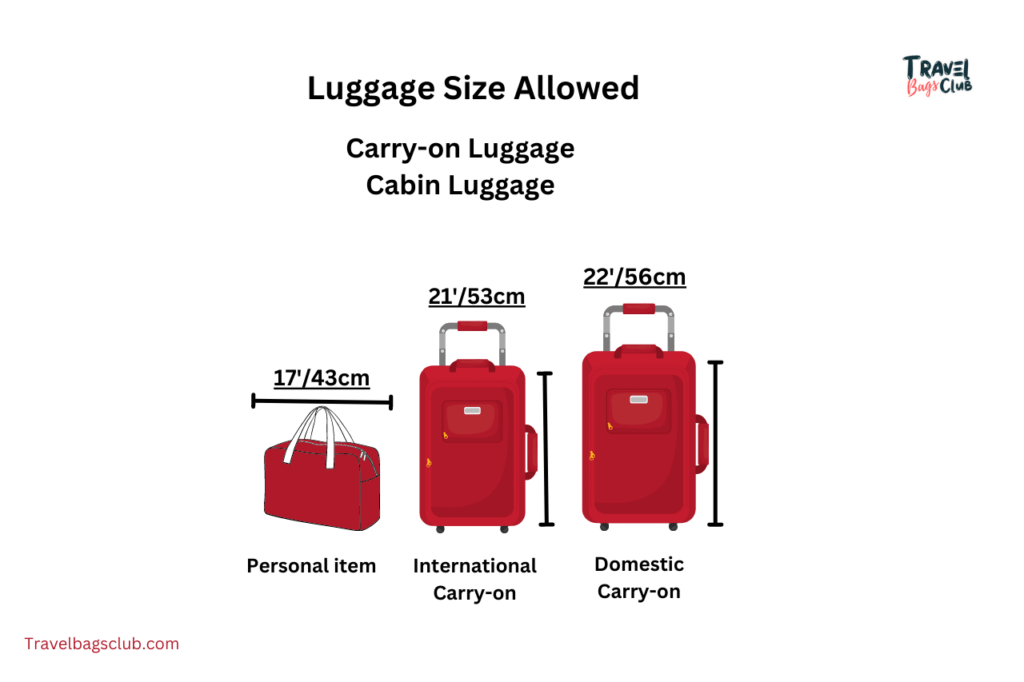
How is Luggage size Measured in inches/cm? – Checked Luggage
| Luggage Type | Dimensions | Weight |
|---|---|---|
| Checked Bag- Economy class | 62 inch/ 158cm | 50lbs/ 23kgs |
| Checked Bag- Business class | 62 inch/ 158cm | 70lbs/ 32kgs |
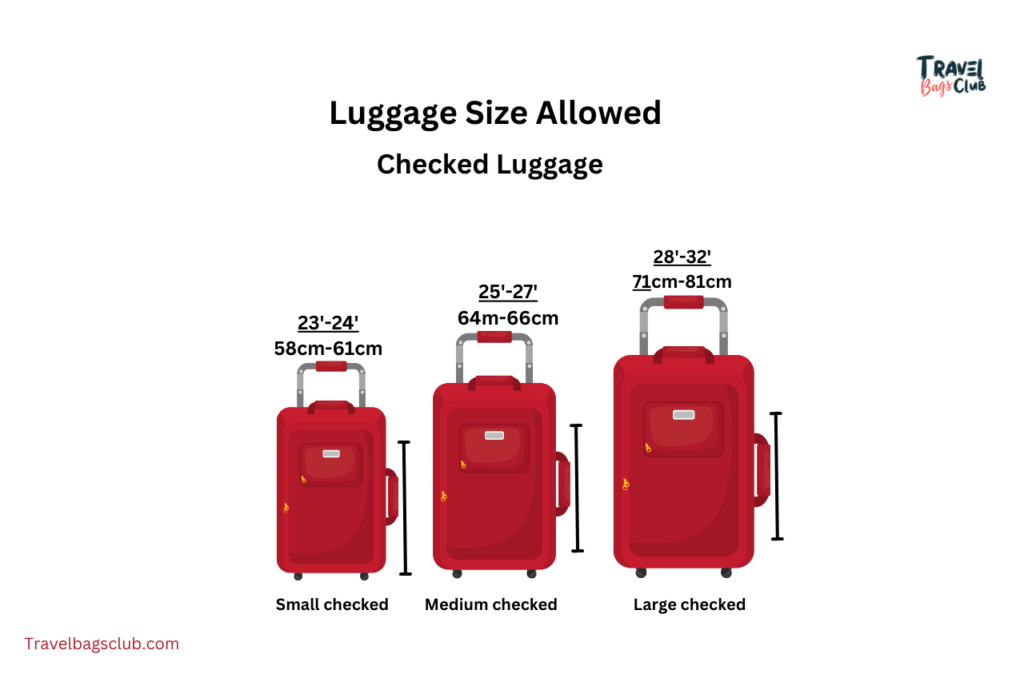
Step 2: Grab an appropriate bag that matches the mentioned measurements
Packing for a trip can be a daunting task, especially when you’re trying to prioritize fitting all of your essential items into the allotted luggage measurements. The best way to ensure that everything is accounted for is by choosing the right size bag for your belongings.
You should also ensure that it meets the airline’s maximum size and weight restrictions. So before you begin packing, make sure that you check the measurements of your desired bag against what is accepted by the airline so that you can travel with peace of mind!
The size and dimension of suitcases usually are indicated on the suitcase or the website if you buy online. Often, manufacturers call suitcases carry-on bags to attract customers, but in reality, those are not carry-on bags; the measurements are not according to airline criteria.
Tip: Prefer measuring your luggage at home and do not believe in manufacturer measurements.
How should one measure luggage?
Step 3: Ensure that bag extensions comply with the size requirements.
We suppose, at this stage, you are aware of the size requirements addressed by the airline. Here we will tell you in detail how luggage is measured with tape so that you can measure your suitcase at home.
First, ensure that bag extensions mean its handles, wheels and any extra zipping compartment are also included in the measurements.
Take the handles out to their maximum length but not the trolly handle and unzip the extra pockets if you are supposed to use that pockets.
Step 4. Pack your bag – with all the extended compartment
Pack your bag like you pack a bag for your upcoming trip – for more accuracy, you can adopt this point.
Use all the extended compartment to keep your belongings – if you use the fabric bag, this point is even more important because fabric bags usually expands in width when fully packed.
Step 5. Weigh your bag and measure it again
Weighing: After fully packing your suitcase, this is the time to weigh your luggage. There are two common ways to weigh your loaded bag.
The first method is to hold the luggage in your hand and step on the regular weighing scale, note the weight, then step on without the luggage and deduct the difference in your weight.
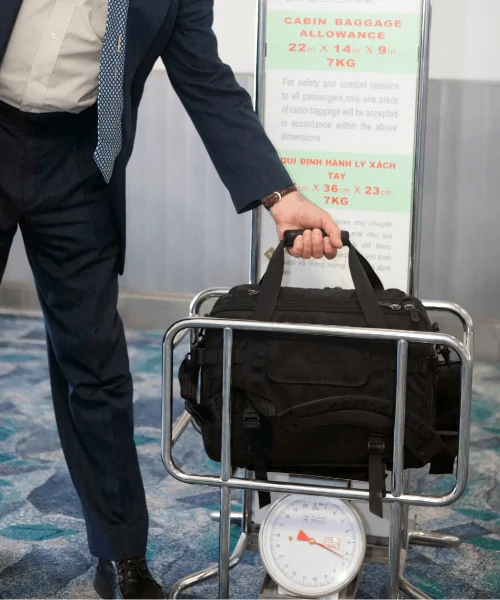
The second method is to use the luggage scale if you have one. Hold the luggage in your hand and note the weight.
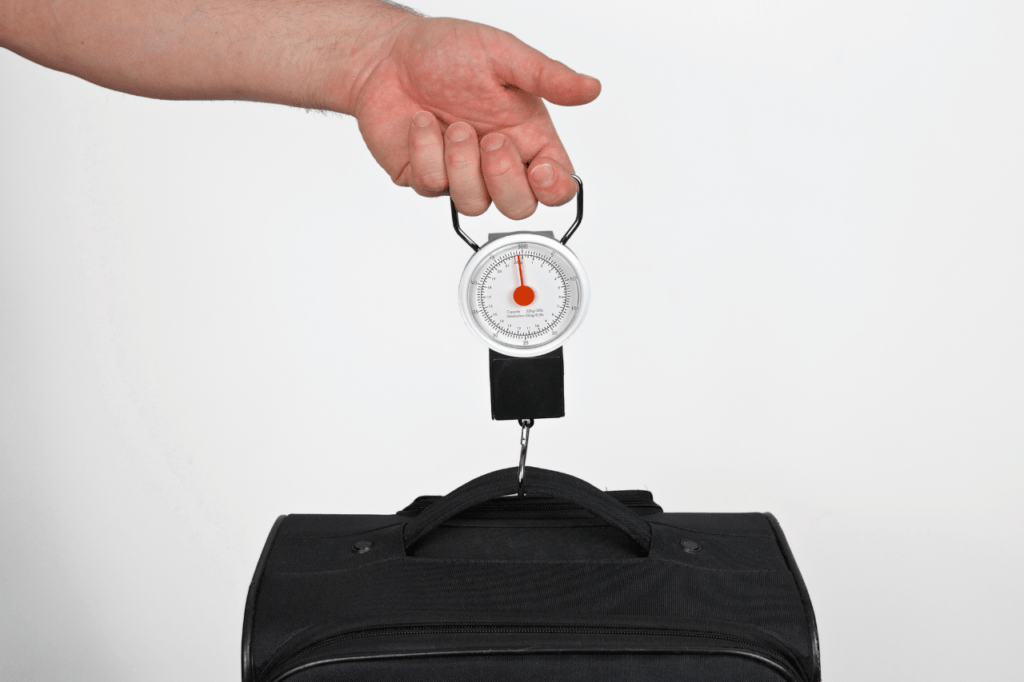
Measurements: Now is the time to take the measurements of your packed luggage. Do follow the airline’s rules to measure it to its widest shape, including handles, wheels and zipping pockets in the measurements.
Tip: Measure your bag with its widest length and width after fully packed.
Try and keep the weight of all your items below the recommended limits, as this will save you time and money on fees.
Step 6. Check your carry-on and checked luggage correctly
Double-check your carry-on and luggage with your airline-specific criteria before air travel. There’s nothing worse than getting a nasty surprise at the check-in counter when they inform you that your bag is on the heavy side and you’ll have to pay extra charges. The trick to avoiding this scenario is properly measuring your bags before leaving for the airport. All it requires is a tape measure or a ruler to get accurate measurements and ensure there won’t be any surprises when you go through check-in.
Otherwise, you may have to pay the fee for extra luggage and face some problems at the airport. To avoid this situation, you must measure your luggage correctly at home.
Tip: It is essential to check the airline’s regulations before measurement to double-check that your luggage fits within the allowed limits.
You May Read: Hardside Vs Softside Luggage – Which Is Best In 2023
PROCEDURE OF MEASURING SUITCASES
When measuring suitcases with a tape measure,
Step 1: The first step is to stand the bag up straight. It will help you accurately measure the suitcase’s height, width, and depth, which are the three basic components of its size limit for airlines.
Step 2: Once your bag is standing up straight, take the end of your tape measure, start at one corner of the suitcase, and extend it all the way down to the other corner. Get length, width and height
Step 3: You can note down the number on your tape measure; this will reveal your bag’s length measurement.
Step 4: Repeat this process to get measurements for width and depth, creating a three-dimensional view of your stored belongings in relation to their luggage size limit restrictions
How is Luggage Measured in Linear inches? – For checked bag
Most airlines use linear inches when measuring checked luggage because it is the most efficient way of determining luggage size. Linear inches refer to the total length of each bag, including the handle and wheels. It gives a complete picture of a bag’s size at a glance rather than trying to compute multiple measurements individually. With linear measurements already determined beforehand, airline staff can quickly identify if a passenger’s bags fit within their airline’s limits.
To measure linear inches, start by looking at the outside of your suitcase and taking note of the length, width, and height in inches.
Once you get those three measurements, add them all together to get your total linear size. It should be at most 62 inches limit, followed by most airlines.
How do you measure 62-inch luggage?
Measuring your luggage to ensure it meets size limits when traveling can save you time, money and hassle. To measure a 62-inch piece of baggage:
- Start by gathering a measuring tape or ruler and standing the suitcase up on its side.
- Place the measuring device edge to edge with the base of the suitcase and extend it up along all sides until you reach 62 inches.
- Check all angles since some suitcases may be slightly uneven in height.
- Get 3 readings of height, width and length. Add all 3 numbers together and get linear measurements that should not exceed 62 inches.
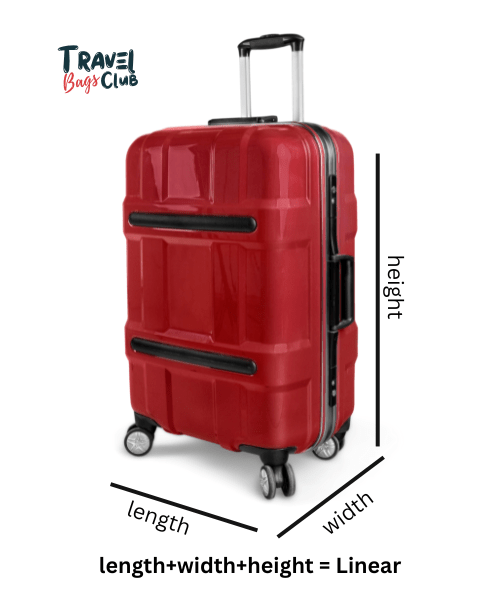
Taking a few minutes out of your travel preparations to measure your suitcase ahead of time can help alleviate some stress on the big day.
Final Words:
You Always wonder how airlines measure your luggage when traveling domestically or going on an international trip. It is really tricky, but you can fulfill all the requirements easily if you have all the information beforehand.
There are different requirements for checked and carry-on luggage. In this article, we tried to cover all related information regarding luggage measurement. Before your next journey, we hope you will check this guide and find it helpful!
FAQs
Do the wheels count when measuring checked luggage?
Yes! Although it may seem like an insignificant fraction of extra space, it could mean the difference between paying a checked baggage fee or getting away without one. Airlines track size and weight carefully, so any miscalculation in measuring can lead to unexpected costs at check-in. Most airlines measure the luggage, including handles, wheels, and other extra parts.
Do airlines allow 24-inch carry-on?
For most airlines, unfortunately, your carry-on will need to fit within the standard size of 22″ x 14″ x 9″; otherwise, you may have trouble bringing it on board. So if you’re aiming for an economy airline flight, stick with a 22-inch bag or smaller!
What are the most common restrictions you face for measuring luggage?
Regarding airline travel, one of the most important things you must consider is the limitations on luggage.
The most common restriction for checked luggage is 50 to 70 pounds or 23 kilograms. Overall dimensions should not exceed 62 inches (length plus width plus height). However, smaller planes may have an even lower weight limit. So you should always check with the airline before departure to ensure that you have measured your luggage correctly.
Are airlines strict with baggage size?
Recently, airlines have become increasingly strict with size and weight restrictions for passengers’ baggage. There are many reasons for this, from the rising fuel cost to space constraints on newer aircraft fleets.
Do airlines really check carry-on size?
Many people wonder how strictly airlines enforce their rules on carry-on baggage size. The truth is that it can vary from airline to airline and from airport to airport. Usually, gate agents will overlook an extra inch or two if your bag isn’t overflowing. Still, if your item breaks the size limit by a significant degree, there is a greater chance that it will single out for inspection.





7 Comments on “How is luggage measured for Air travel? – Complete guide”